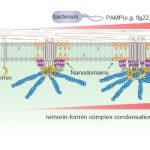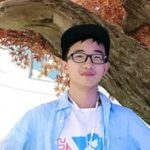Zhongshou Wu: The Plant Cell First Author

 Zhongshou Wu, co-first author of “The N-terminally truncated helper NLR NRG1C antagonizes immunity mediated by its full-length neighbors NRG1A and NRG1B“
Zhongshou Wu, co-first author of “The N-terminally truncated helper NLR NRG1C antagonizes immunity mediated by its full-length neighbors NRG1A and NRG1B“
Current Position: Postdoctoral fellow in Dr. Steven Jacobsen’s group at University of California, Los Angeles, USA
Education: PhD, University of British Columbia, Canada; MSc, Northwest A&F University, China
Non-scientific Interests: tennis, hiking, watching movies
Brief bio: My interest in plant-microbe interaction began during my early research in the lab of Dr. Jin-Rong Xu when I was working on the rice blast pathogen during my MSc study. Afterwards, I had the opportunity to join Dr. Xin Li’s lab at University of British Columbia to study the activation and homeostasis control of intracellular immune receptors (NLRs). Immune functions of TNLs, a subgroup of NLRs, depend on helper NLRs (ADR1 and NRG1) and three lipase-like proteins (EDS1, PAD4, and SAG101). Together with scientists in Jane Parker and Jonathan Jones’ groups, we found that TNLs’ activation triggers the assembly of two complexes, EDS1-PAD4-ADR1 and EDS1-SAG101-NRG1. In addition, these two complexes also play an important role in boosting the plasma-membrane localized receptor-triggered immunity (termed PTI). Another interesting evolutionary phenomenon is that an N-terminally truncated NRG1C variant clusters together with full-length NRG1A/1B in the genomes across Brassicaceae species. Mechanistical analysis now show that this truncated NRG1C can antagonize immunity mediated by its full-length neighbors. Following my scientific interest in computational biology and epigenetics, I am now working with Dr. Steven Jacobsen on transcriptional silencing and histone modification.
姓名: 吴忠寿
当前职位:加州大学洛杉矶分校博士后
教育背景:加拿大英属哥伦比亚大学博士,西北农林科技大学硕士
兴趣爱好:网球,爬山,看电影
个人简历:本科毕业后,我对于植物与病原菌互作非常感兴趣,并有幸加入许金荣教授课题组研究水稻和稻瘟病菌之间的互作。之后,我加入了英属哥伦比亚大学李昕教授课题组研究植物胞内免疫受体蛋白的激活和调节机制。TNL胞内免疫受体蛋白的激活通常需要辅助型受体蛋白(ADR1和NRG1)以及三个类脂肪酶蛋白(EDS1,PAD4和SAG101)的帮助来传递免疫信号。今年,我以第一作者和共同第一作者分别在Plant Physiology和Nature发表实验数据证明,TNL胞内受体蛋白激活后可以促进两个复合体(EDS1-PAD4-ADR1 和 EDS1-SAG101-NRG1)的形成,而这两个复合体在促进定位于细胞膜上的免疫受体激活的免疫反应中也起着重要作用。而另一个有意思的进化现象是,一个蛋白N端大部分缺失的NRG1C 同源基因与NRG1基因形成非常保守的基因簇存在于很多植物基因组中。我们的实验证明这个N端缺失的NRG1C蛋白可以抑制全长的NRG1A/B蛋白的功能来负调控免疫反应。现阶段,我在Dr. Steven Jacobsen(UCLA)课题组研究转录抑制以及组蛋白修饰之间的关系。



